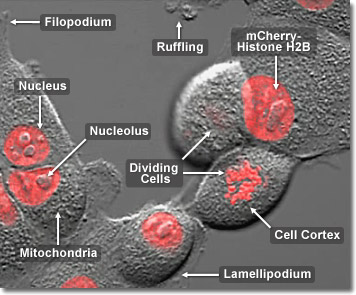The first stage of mitosis is known as prophase, where the nuclear chromatin starts to become organized and condenses into thick strands that eventually become chromosomes observable in the optical microscope. The nucleoli, primarily responsible for the production of ribosomal RNA, begin to disappear as the chromosomes condense. During prophase, major changes also occur in the cytoplasm, including disassembly of the cytoskeleton components based on tubulin (cytoplasmic microtubules). The tubulin monomers are dynamically redirected by the dividing cell to form the main component of the mitotic apparatus, the mitotic spindle, which is bounded by the centrosomes and begins to appear along the periphery of the nuclear membrane. In the digital video presented above, rabbit kidney (RK-13 line) epithelial cells labeled with the fluorescent protein, mCherry, fused to human histone H2B (orange-red nuclei) are observed undergoing mitosis using confocal illumination at 543 nanometers accompanied by differential interference contrast (DIC) in transmitted light. Although the two labeled cells in this video don't enter mitosis during the course of the time-lapse sequence, they were nevertheless members of a larger population of rapidly dividing cells.
Video 1 - Run Time: 47 Seconds
Video 2 - Run Time: 57 Seconds
Video 3 - Run Time: 67 Seconds
Video 4 - Run Time: 53 Seconds
Video 5 - Run Time: 56 Seconds
Video 6 - Run Time: 62 Seconds
Video 7 - Run Time: 59 Seconds
Video 8 - Run Time: 52 Seconds
Video 9 - Run Time: 48 Seconds
Video 10 - Run Time: 55 Seconds
Video 11 - Run Time: 44 Seconds
Video 12 - Run Time: 50 Seconds
Although very little activity is observable in the cell nucleus with fluorescence microscopy during interphase and the period is not considered to be a formal step in mitosis, this stage represents an essential preparation for cell division because the chromosomes are replicated during interphase. In addition to the synthesis phase, which occurs during the central portion of interphase, the cell cycle also consists of two gap (abbreviated G) stages that precede and follow the synthesis phase. For most animal cells, the interphase portion accounts for approximately 90 percent of the cell cycle, whereas mitosis is accomplished in the remaining period. In the digital video presented above, rabbit kidney (RK-13 line) epithelial cells labeled with the fluorescent protein, mCherry, fused to human histone H2B (orange-red nuclei) are observed undergoing mitosis using confocal illumination at 543 nanometers accompanied by differential interference contrast (DIC) in transmitted light.

The timeframe for completion of the entire cell cycle (the gap, synthesis, mitosis, and cytokinesis phases) varies depending upon the organism. For example, the common bean cell completes the cycle in about 19 hours, with 7 hours dedicated to the S period and two approximately equal length gap phases of 5 hours each. In this species, mitosis lasts about two hours. In contrast, mouse fibroblast cells in culture feature a cycle that lasts 22 hours, with mitosis being completed in only one hour. The synthesis phase in these mammalian rodent cells takes almost 10 hours, while G(1) lasts almost as long, or about 9 hours. In the digital video presented above, rabbit kidney (RK-13 line) epithelial cells labeled with the fluorescent protein, mCherry, fused to human histone H2B (orange-red nuclei) are observed undergoing mitosis using confocal illumination at 543 nanometers accompanied by differential interference contrast (DIC) in transmitted light. Although the two labeled cells in this video don't enter mitosis during the course of the time-lapse sequence, they were nevertheless members of a larger population of rapidly dividing cells.